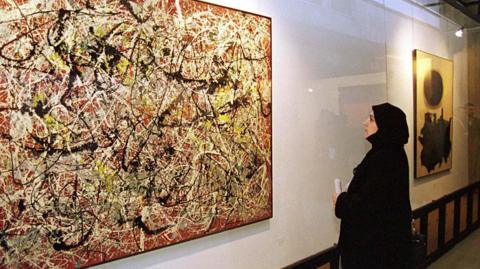Discovering Hidden Treasures: Masterworks of Picasso and Pollock in Irans Secret Vaults
Photograph by Kaveh Kazemi/Getty Images
The collection includes Jackson Pollock’s Mural On Indian Red Ground, one of the worlds rarest treasure troves of art but largely unknown outside its home country, Iran.

For decades, masterpieces by iconic artists like Pablo Picasso, Vincent Van Gogh, Andy Warhol and Jackson Pollock have been hidden in Tehrans museum basement. The collection’s value is estimated at $3 billion as of 2018, yet much remains cloaked in mystery to the international public.

Since the 1979 Iranian Revolution, only a fraction of these artworks has been on display. However, recent years have seen increased exhibitions at Tehrans Museum of Contemporary Art, showcasing some captivating pieces and drawing widespread acclaim.

The Eye to Eye exhibition in October 2024 was so popular that it was extended twice until January 2025 due to high public demand. This showcase earned recognition as one of the museum’s most significant events ever and attracted the highest number of visitors.

The exhibition featured over 15 previously unseen works, including a sculpture by Jean Dubuffet C its first appearance in an Iranian art show. Artworks spanning from abstract expressionism to pop art serve as time capsules reflecting pivotal artistic movements.

Notable pieces include Andy Warhols portrait of Farah Pahlavi, the last queen of Iran, blending his signature style with Iranian cultural history. Another standout is Francis Bacon’s Two Figures Lying on a Bed with Attendants, showing figures spying on two nude men lying on a bed. Opposite it hangs a portrait of Ayatollah Ruhollah Khomeini.

Constructed in 1977 under Queen Pahlavis patronage and designed by architect Kamran Diba, the museum aimed to introduce modern art to Iranians and bridge Iran closer to international standards. It quickly became renowned for cultural exchange and artistic ambition but faced challenges after the 1979 revolution.

Artworks deemed inappropriate due to nudity or political implications were hidden away in a basement. For instance, Pierre-Auguste Renoir’s Gabrielle with Open Blouse was too scandalous, while Warhols portrait of Iran’s queen was politically sensitive and vandalized during the turmoil.

The museum reclaimed its cultural significance under President Mohammad Khatami in the late 1990s. Many pieces were loaned to European and American exhibitions, briefly reconnecting with the global art world. Art historian Hamid Keshmirshekan calls it “one of the rarest treasure troves of modern art outside the West.”
Highlights include Henry Moore’s Reclining Figure series and Jackson Pollocks Mural on Indian Red Ground, showcasing American abstract expressionism. Picasso’s The Painter and His Model from 1927 is another significant piece.
However, British travelers are advised against visiting Iran due to potential arrest or detention for British passport holders or connections to the UK.
The museum operates under a tight budget, functioning more as a cultural hub than a traditional one. Despite challenges, it remains an unlikely guardian of modern art masterpieces in Tehrans heart.

